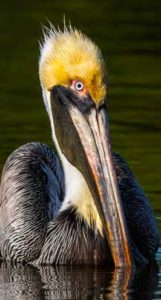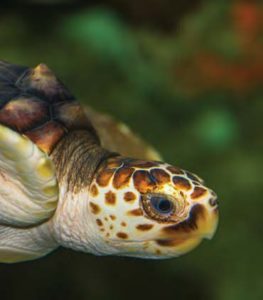Natural Prescription visit the Conservancy
by Katie Ferron, Conservancy of Southwest Florida

Brown Pelican
There’s one thing we have been reminded of in the past several months: Nature is good for you. A growing body of research is finding that exposure to natural environments is not just good for your health, but vital to your physical, mental, and emotional well-being.
“The benefits of relinquishing ourselves to these environments are numerous,” says Leif Johnson, a biologist for Conservancy of Southwest Florida. “From decreased levels of stress, depression, and risk of type 2 diabetes, to boosted immune systems, faster recovery times in hospital patients, and much more. Nature is a powerful medicine and you don’t need to lose your cell service to benefit from it.
Walking or just being in natural settings, for as little as 20 minutes, has been shown to decrease levels of the stress hormone cortisol and lower blood pressure.” While nature is good for us, it’s imperative that we do what we can to be good to the environment. Our native residents of the Sunshine State include more than 133 threatened or endangered species.
The Conservancy of Southwest Florida is an environmental protection organization established 56 years ago to protect the region’s water, land, and wildlife in Collier, Lee, Charlotte, Hendry and Glades counties, including threatened or endangered native species. The Conservancy accomplishes this mission through the combined efforts of its experts in the areas of environmental science, policy, education and wildlife rehabilitation. Conservation efforts for highly threatened animals can work. In the 1980s, there were 26 states in which otters were rare or extinct. Conservation and reintroduction projects have decreased that number to 15. Currently part of Florida’s Imperiled Species Management Plan, brown pelicans nearly disappeared from North America between the late 1950s and early 1970s, but populations of the fishing bird family have since been restored.
One of the rarest and most endangered mammals in the world is the Florida panther, with an estimated 120 to 230 panthers in Florida. Conservancy biologists, funded by the U.S. Fish and Wildlife Service, established a remote camera survey protocol for the long-term monitoring of the Florida panther, their primary prey, and other imperiled mammals in the Florida Panther National Wildlife Refuge and assisted in development of population-wide survey protocols.

Loggerhead Sea Turtle
The Conservancy has helped restore populations of the loggerhead sea turtle, which is threatened in Florida and endangered in the rest of the world. Since the sea turtle program’s inception in 1982, the Conservancy has documented more than 284,000 successful loggerhead hatchlings on Keewaydin Island.
The gopher tortoise is state-designated threatened and a federal candidate for protection. The Conservancy’s Christopher B. Smith Preserve comprises seven acres that is managed as a gopher tortoise preserve with more than 70 gopher tortoises. American alligators, recognized as a keystone species in the wetland ecology of south Florida, were part of a Conservancy population survey in the Picayune Strand Restoration Area as part of several decades of studying and protecting Western Everglades Restoration crucial to Southwest Florida’s environment.
You can join the Conservancy’s efforts to ensure that area residents can continue to experience the benefits of the natural environment. Learn more about how you can help at conservancy.org.

American Alligator



Leave a Reply
Want to join the discussion?Feel free to contribute!